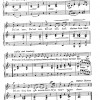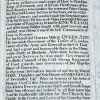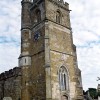For those living in Beaminster the name of Hine would have a familiar ring, especially if they live in Hogshill Street. The White Hart brewery, almost half way up the street on the right, was formerly the premises of the Hine family – specifically Thomas Hine, founder of the Cognac-distilling business that bears his name.
Thomas the distiller was born in 1775, one of seven sons of another Thomas Hine and his wife Elizabeth, who also had four daughters (the baptisms of five of these eleven children were recorded in the Congregational Chapel register.) The father, Thomas senior, was descended from the senior of two lines or branches of the family that can be traced back to one Thomas Hine, then landlord of the Three Horseshoes inn in Powerstock, and his first wife Edith. The family line, in which the last Thomas (the Cognac maker) belonged, began with the marriage of the landlord’s son, Thomas Jr, to Elizabeth Daniel in 1762. Elizabeth was the great-granddaughter of the Royalist rebel James Daniel who fought on the side of Monmouth at Sedgemoor.
Thomas Jr became a cloth maker in Beaminster, dealing in products that included drab cloth, sheeting, blanketing, serge, flannel, hankies, thread and buttons. His premises were at what is today No 21 Market Square. Aside from his trade, Thomas was also a leading light of the town’s Congregational Chapel for 50 years. In 1767 his name appeared on a list as a subscriber, collecting funds for repairs to the meeting house. He was admitted as a communicant in 1777 and made a deacon in 1796.
The following year Jeremiah Newman, a surgeon of Beaminster, sold 19 Hogshill Street (later known as Devonia) to Thomas. This building was raised on the site of three former timber houses that had burnt down in the Beaminster fire of 1781. Elizabeth Hine died in 1814, and when Thomas died in 1817 Devonia came into the possession of his eldest son James, who in turn would pass it down to his brother Richard within a year.
Cognac maker Thomas Jr became the best known of the sons of Thomas and Elizabeth. As a young man he may have worked for some time as a cloth maker in his family’s tradition, though unlike some of his brothers he did not remain at home to pursue his father’s occupation. Instead he evidently cultivated an abiding fascination for all things Gallic, notwithstanding the intense animosity prevailing between England and Napoleon’s ascendant Frankish Empire at the time.
Out of a desire to learn the French language and culture, Thomas crossed the Channel in 1793 when the revolution was already underway, and proceeded to Jarnac, soon after which, war with England broke out. Consequently, expatriate Britons or visitors found themselves being promptly incarcerated as prisoners of war, and in September 1793 Hine was himself arrested and imprisoned in nearby Cognac.
As it happened this town, in the French Department of Charente, had been a centre for the distilling of high-quality brandy since the 17th century (the names Cognac or Armagnac incidentally, have also since become applied to the casks or barrels in which brandy is matured.) However, Hine had friends at the town hall and through their good offices and intervention Thomas was released in May 1794.
Once freed, Hine found employment with the local business of Ranson, Delamain & Co., brandy producers of Jarnac. This brought him into romantic contact with Delamain’s daughter Francoise Elizabeth and three years later in 1797 they were married. Not long before or after, Thomas became a partner in the business, and Ranson, Delamain & Co became Thomas Hine & Co., from where the couple’s descendants spread the name of Cognac throughout the world. Thomas had found his vocation for life, and came to serve as an honorary citizen on Jarnac’s Municipal Council for many years until his death in 1822.
Thomas’s eldest son by Francoise became the first first-generation descendant of an English immigrant ever to be elected mayor of a French town. Today the sixth generation of Thomas Hine’s descendants maintain the distilling business at the Jarnac headquarters, from where they distribute their product to 150 countries.
The two lines of the family remaining in Beaminster however, finally ceased in 1939 with the death of Richard Hine, the town’s chemist, but also a photographer, Congregationalist and popular local citizen. He also wrote a history of Beaminster that was published in 1914. When the chapel was closed and converted to use as the museum, memorabilia of this Hine was put on display in the ground floor gallery. Richard was not a descendant of Powerstock innkeeper Thomas by his first wife Edith as the Cognac-making Thomas had been, but by his second wife Lydia.



